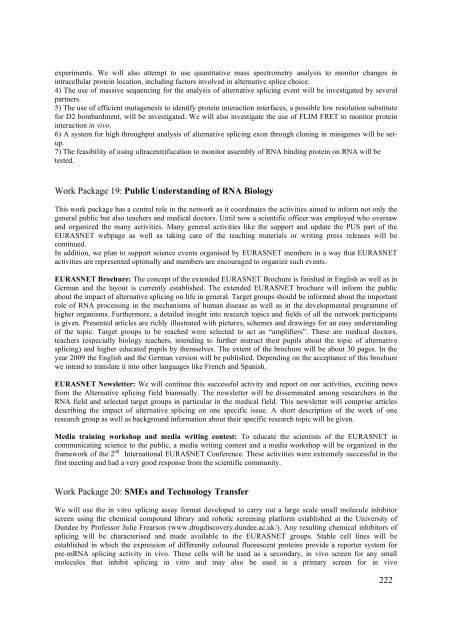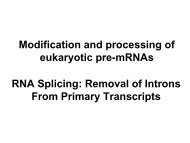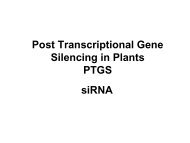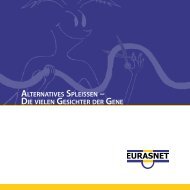You also want an ePaper? Increase the reach of your titles
YUMPU automatically turns print PDFs into web optimized ePapers that Google loves.
experiments. We will also attempt to use quantitative mass spectrometry analysis to monitor changes inintracellular protein location, including factors involved in alternative splice choice.4) The use of massive sequencing for the analysis of alternative splicing event will be investigated by severalpartners.5) The use of efficient mutagenesis to identify protein interaction interfaces, a possible low resolution substitutefor D2 bombardment, will be investigated. We will also investigate the use of FLIM FRET to monitor proteininteraction in vivo.6) A system for high throughput analysis of alternative splicing exon through cloning in minigenes will be setup.7) The feasibility of using ultracentrifucation to monitor assembly of RNA binding protein on RNA will betested.Work Package 19: Public Understanding of RNA BiologyThis work package has a central role in the network as it coordinates the activities aimed to inform not only thegeneral public but also teachers and medical doctors. Until now a scientific officer was employed who oversawand organized the many activities. Many general activities like the support and update the PUS part of the<strong>EURASNET</strong> webpage as well as taking care of the teaching materials or writing press releases will becontinued.In addition, we plan to support science events organised by <strong>EURASNET</strong> members in a way that <strong>EURASNET</strong>activities are represented optimally and members are encouraged to organize such events.<strong>EURASNET</strong> Brochure: The concept of the extended <strong>EURASNET</strong> Brochure is finished in English as well as inGerman and the layout is currently established. The extended <strong>EURASNET</strong> brochure will inform the publicabout the impact of alternative splicing on life in general. Target groups should be informed about the importantrole of RNA processing in the mechanisms of human disease as well as in the developmental programme ofhigher organisms. Furthermore, a detailed insight into research topics and fields of all the network participantsis given. Presented articles are richly illustrated with pictures, schemes and drawings for an easy understandingof the topic. Target groups to be reached were selected to act as “amplifiers”. These are medical doctors,teachers (especially biology teachers, intending to further instruct their pupils about the topic of alternativesplicing) and higher educated pupils by themselves. The extent of the brochure will be about 30 pages. In theyear 2009 the English and the German version will be published. Depending on the acceptance of this brochurewe intend to translate it into other languages like French and Spanish.<strong>EURASNET</strong> Newsletter: We will continue this successful activity and report on our activities, exciting newsfrom the Alternative splicing field biannually. The newsletter will be disseminated among researchers in theRNA field and selected target groups in particular in the medical field. This newsletter will comprise articlesdescribing the impact of alternative splicing on one specific issue. A short description of the work of oneresearch group as well as background information about their specific research topic will be given.Media training workshop and media writing contest: To educate the scientists of the <strong>EURASNET</strong> incommunicating science to the public, a media writing contest and a media workshop will be organized in theframework of the 2 nd International <strong>EURASNET</strong> Conference. These activities were extremely successful in thefirst meeting and had a very good response from the scientific community.Work Package 20: SMEs and Technology TransferWe will use the in vitro splicing assay format developed to carry out a large scale small molecule inhibitorscreen using the chemical compound library and robotic screening platform established at the University ofDundee by Professor Julie Frearson (www.drugdiscovery.dundee.ac.uk/). Any resulting chemical inhibitors ofsplicing will be characterised and made available to the <strong>EURASNET</strong> groups. Stable cell lines will beestablished in which the expression of differently coloured fluorescent proteins provide a reporter system forpre-mRNA splicing activity in vivo. These cells will be used as a secondary, in vivo screen for any smallmolecules that inhibit splicing in vitro and may also be used in a primary screen for in vivo222







